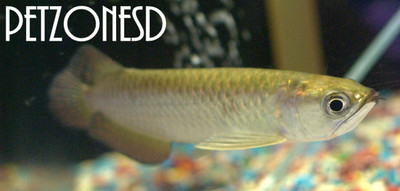Jardini Arowana (Scleropages jardinii)
Posted by Max Gandara on on 18th Sep 2024
Jardini Arowana (Scleropages jardinii)
The Jardini Arowana, Scleropages jardinii, is a striking, highly sought-after freshwater fish known for its majestic swimming style and shimmering scales. Originating from northern Australia and New Guinea, the Jardini Arowana is a close relative of the Asian Arowana and is prized by aquarists for its unique beauty and commanding presence in large tanks.
Natural Habitat
In the wild, Jardini Arowanas inhabit slow-moving rivers, floodplains, and swampy areas in northern Australia and New Guinea. These waters are typically murky and have a lot of submerged vegetation and floating debris, providing cover for the Arowana to hunt. As ambush predators, they lurk near the water's surface, waiting to strike at unsuspecting prey, which includes small fish, insects, and even birds or small mammals that venture too close to the water.
Appearance
Jardini Arowanas are renowned for their large, elongated bodies and striking metallic scales. Their coloration is often a mix of silver, bronze, and gold with hints of red or pink, especially on their fins. The fish have a pronounced pair of barbels on their lower jaw, which they use to sense their environment. Jardini Arowanas can grow up to 24-30 inches (60-75 cm) in length, making them one of the larger species in the aquarium trade.
Aquarium Care
Due to their large size and territorial behavior, Jardini Arowanas require specific care to thrive in captivity.
- Tank Size: A tank of at least 180 gallons (680 liters) is recommended for an adult Jardini Arowana, though larger tanks are preferable. These fish are active swimmers and need plenty of horizontal space to move. They also require a securely covered tank, as Arowanas are known to jump, sometimes with great force.
- Water Parameters: Jardini Arowanas thrive in water temperatures between 75°F and 82°F (24°C - 28°C) with a pH range of 6.5 to 7.5. While they can tolerate a range of conditions, stable water parameters and excellent filtration are crucial, as these large fish produce significant waste. Regular water changes are essential to maintain optimal water quality.
- Tank Setup: In their natural habitat, Jardini Arowanas are accustomed to minimalistic surroundings with open water for swimming and some submerged roots or plants for cover. In an aquarium, it’s best to replicate this environment with minimal decorations that provide hiding spots but do not impede the fish’s swimming space. Large driftwood or floating plants can help create a more natural environment, but ensure that there are no sharp objects that could damage their delicate fins.
- Diet: Jardini Arowanas are carnivorous and should be fed a varied diet of high-protein foods. In captivity, they can be fed pellets specifically designed for large carnivorous fish, as well as live or frozen foods like crickets, mealworms, shrimp, and small fish. They may also accept freeze-dried or frozen bloodworms and other protein-rich foods. It’s important to offer a balanced diet to maintain their health and coloration.
- Behavior and Tank Mates: Jardini Arowanas are known for their territorial and sometimes aggressive behavior, particularly as they mature. While juveniles may tolerate tank mates, adults often become solitary and may attack other fish, even those of similar size. Suitable tank mates must be large, robust species, but keeping Jardini Arowanas in solitary tanks is often the best option to avoid conflicts.
Breeding
Breeding Jardini Arowanas in captivity is very rare due to their large size and territorial nature. In the wild, they are mouthbrooders, with males carrying the fertilized eggs in their mouths until the fry hatch. Even if breeding were to occur in an aquarium, it would require a very large, specialized setup to accommodate the breeding pair and their territorial behaviors.
Common Issues
One of the main challenges in keeping Jardini Arowanas is their aggressive behavior, which can result in injuries to tank mates or even to themselves if they jump and hit the tank lid. It’s also important to ensure they have a diet rich in variety, as malnutrition can lead to health problems and poor coloration.
Another issue is their susceptibility to external parasites and fungal infections, especially if water quality is not maintained. Regular water changes and a good filtration system are key to preventing stress and disease.
Conclusion
The Jardini Arowana is a stunning, formidable fish that can be a rewarding addition to large home aquariums. However, due to their size, aggressive tendencies, and specific care requirements, they are best suited for experienced aquarists who can provide the proper environment and attention.
With the right care and dedication, the Jardini Arowana will grow to become a magnificent centerpiece in your aquarium, showcasing its grace, power, and captivating beauty.

